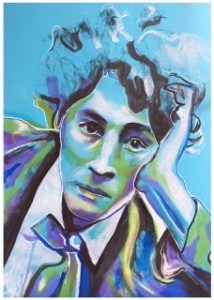✱ “unknown northern land”

The ancients, the Greeks and Romans, perceived the world of their day as one with the Mediterranean at its centre, surrounded by the conjoined land masses of Europe, Africa and Asia, comprising what the Greeks called oikouménē, the known, inhabited or inhabitable parts of the worldⓐ. This envisaged world was “a curious place where legends and reality could co-exist” [Vedran Bileta, “3 Legendary Ancient Lands: Atlantis, Thule, and the Isles of the Blessed”, The Collector, 03-Nov-2022, www.thecollector.com]. The Greeks believed that at the northernmost extremity of the existing world lay a fabled island called Thuleⓑ. The originator of this belief was 4th century BC Greek explorer Pytheas of Massalia (now Marseille, Fr.) who claimed to have visited and discovered Thule on a voyage beyond Britain to the northern sea and the Arctic. Pytheas introduced the idea of Thule—far distant and encompassed by drift-ice and possessed of a magical midnight sun—to the geographic imagination. Other ancient writers enthusiastically took up Pytheas’ fantastical notion, notwithstanding that the account of his journey (On the Ocean) had been lost to posterity…Pliny the Elder (1st century AD) described Thule as “the most remote of all those lands recorded”; Virgil (1st century BC) called the island Ultima Thule, (“farthermost Thule”, ie, “the end of the world”).

Thule, as Tile (1539 map) shown (with surrounding sea-monsters) as located northwest of the Orkney islands
Seeking Thule: The loss of Pytheas’ primary source text, the description of his voyage, led countless generations that followed him to speculate as to where the exact location of Thule might be. Many diverse places have been misidentified as Thule…the Romans thought it was at the very top of Scotland, in the Orkneys; Procopius (6th century AD Byzantine historian), Scandinavia; early medieval clerics located it in Ireland while both the Venerable Bede and Saxon king Alfred the Great asserted that Iceland was really Pytheas’s Thule, as did the famous 16th century cartographer Mercator. Other candidates advanced over the millennias include Greenland, Norway, the Faroe Islands, Shetland, “north of Scythia”, Smøla (Norway) and Saaremaa, an Estonian island.

Other conjectures on Thule’s whereabouts have been meaninglessly vague, eg, Petrarch (14th century Italian humanist scholar): Thule lay in “the unknown regions of the far north-west”, supposedly inhabited by blue-painted residents (Roman poets Silius Italicus and Claudian), a probable conflation with the Picts of northern Britain. Thule, from as early as the 1st century AD on, “became more of an idea than an actual place, an abstract concept decoupled from the terrestrial map, simultaneously of the world and otherworldly”…an emblem of mystical isolation, liminal remoteness, a real discovered place and yet unknown” (F. Salazar, “Claiming Ultima Thule”, Hakai Magazine, 08-Sep-2020, www.hakaimagazine.com).

Thule has continued to attract the interest of explorers right up to modern times. Continent-hopping scholar-explorer Sir Richard Burton visited Iceland, writing it up as the real “Thule”. Famed Norwegian polar explorer Fridtjof Nansen having explored the Arctic region, produced an account of Pytheas’s ancient Arctic expedition, hypothesising that Thule was in fact a Norwegian off-shore island that the Greek voyager had identified [Nansen F., In Northern Mists, Vols I & II, (1969)]. Greenlandic-Danish explorer and Eskimologist Knud Rasmussen underlined the case for Greenland as the location by naming the trading post he founded in NW Greenland “Thule” or “New Thule” (later renamed in the Inuit language, “Qaanaaq”)ⓒ.

Thule Society: In the aftermath of World War 1 Thule provided stimulus of a very different kind for extreme-right racist nationalists in Germany. An emerging Munich-based secret occultist and Völkisch group named itself after Pythea’s mythical northern island. The Thule Society (Thule-Gesellschaft) propagated a form of virulent anti-Semitism which fed early Nazism in Bavaria, it also preached Ariosophy (an outgrowth of Theosophy), a bogus ideology preoccupied with visions of Aryan racial superiority, a key component of the later Nazis’ ideological frameworkⓓ. Out of the Thule Society came the ultranationalist Germany Workers’ Party (DAB)which in a short time transformed into the National Socialist Workers Party (Nazi Party). A number of Thulists (eg, Hess, Frank, Rosenberg) became prominent in the Nazi leadership during the Third Reich [David Luhrssen, Hammer of the Gods: The Thule Society and the Birth of Nazism (2012)].
Endnote: Hyperborea’s remote utopia Greek mythology throws up a parallel legend to that of Thule in the Hyperboreans. These were mythical eponymous people living in Hyperborea (hyper = “beyond”, boreas = “north wind”ⓔ). Their homeland was perpetually sunny and temperate (despite lying within a cold, frigid region), and Hyperboreans were divinely blessed with great longevity, the absense of war and good health…in other words, a utopian society [‘Hyperborea’, Theoi Project – Greek Mythology, www.theoi.com]. As with Thule, locating this paradisiacal northern land has proved elusive to pinpoint with the ancient scribes and geographers agreeing only that it lies somewhere on the other side of the Riphean Mountains (which themselves have been variously located). Homer described Hyperborea as being north of Thrace, some other classical geographers had it beyond the Black Sea, vaguely somewhere in Eurasia, perhaps in the Kazakh Steppes. Herodotus (5th century BC) had it in the vicinity of Siberia, while for Pindar (fl. 5th century BC) it was near the Danube. Apollonius of Rhodes (3rd century BC) identified the Hyperboreans with the Celts and Britain, Plutarch (fl. 1st century AD) , with Gaul.


ⓐ which, they believed, itself was surrounded by an unbroken chain or body of water
ⓑ a belief shared by the Romans who saw Thule as the extreme edge of orbis terrarum
ⓒ from 1953 to 2023 the northernmost US Air Force base (NW Greenland) was called the Thule Air Base
ⓓ Thule was symbolically important to the right wing nationalists, a pseudo-spiritual home of Aryanism, further “proof” of the mythic origins of the “Germanic race”
ⓔ Hyperborean = “inhabitant of the extreme north”

















